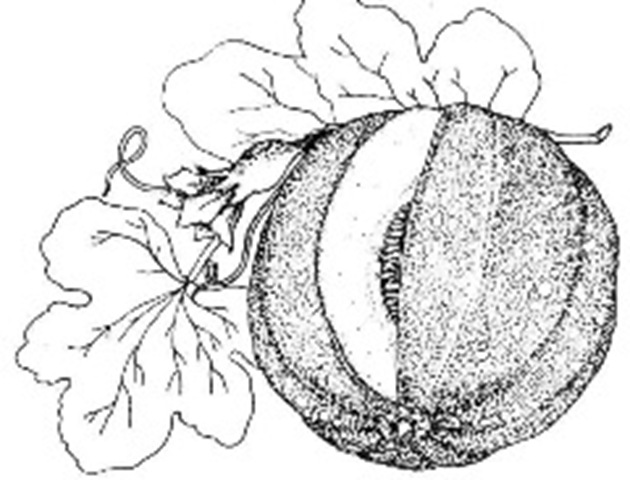Common names: muskmelon,
cantaloupe, cantaloup Botanical name: Cucumis melo Origin: South Asia, tropical Africa
Varieties
Muskmelons are very dependent on climate and growing conditions. Check with your garden center or local extension office for the varieties that grow best in your area.
Description
The muskmelon is a long, trailing annual that belongs to the cucumber and watermelon family. The netted melon or

Muskmelon
muskmelon is usually called a cantaloupe, but it should not be confused with the real cantaloupe, which is a warty or rock melon. The word cantaloupe means “song of the wolf” and was the name of an Italian castle. In 1885, when William S. Ross brought two barrels of muskmelons into the South Water Market in Chicago, everyone laughed at the little melons. Ross, however, laughed all the way to the bank. The U.S. Department of Agriculture spells it cantaloup, without the final “e.”
Another type of melon you may like to try in your garden is the honeydew. It’s sometimes referred to as a winter melon, but again the name is inaccurate — the true winter melon is a Chinese vegetable. Honeydews
have a smoother surface than muskmelons, and lack their distinctive odor. They also ripen later and require a longer growing season, which means that they will not ripen fully in short-season areas. Your Cooperative Extension Service will advise you on growing honeydews in your area. The following growing information for muskmelons applies also to honeydews.
Where and when to grow
Muskmelon is a tender, warm-weather plant that will not tolerate even the slightest frost. It also has a long growing season, which means that you must be careful to select a variety suited to your area’s climate. In cool areas you’ll do better with small-fruited varieties; in warmer areas, where you can accommodate their need for a longer season, you can grow the large varieties. In cool areas grow muskmelons from transplants, using individual, plantable containers at least four inches in diameter so that the root systems are not disturbed when you plant them. Set the plants in the garden when the ground is thoroughly warm, two to three weeks after your average date of last frost.
How to plant
Muskmelons must have full sun and thrive in well-drained soil that is high in organic matter. When you’re preparing the soil, dig in a complete, well-balanced fertilizer at the rate of one pound per 100 square feet or 10 pounds per 1,000 square feet. Grow muskmelons in inverted hills spaced four to six feet apart. If you’re planting from seed, plant six to eight seeds in each hill; when
the seedlings have developed three or four true leaves, thin them to leave the strongest two or three seedlings In each hill. Cut the thinned seedlings with scissors at soil level to avoid damaging the survivors’ root systems. Where cucumber beetles, other insects, or weather are a problem, wait a bit before making the final selection. If you’re using transplants, put two or three in each hill.
Fertilizing and watering
Fertilize before planting and again at midseason, at the same rate as the rest of the garden. Detailed information on fertilizing is given in “Spadework: The Essential Soil” in Parti.
Muskmelons need a lot of water while the vines are growing. Be generous with water until the melons are mature, then stop watering while the fruit ripens.
Special handling
To keep competitive plants weeded out, cultivate carefully until the vines cover the ground. The roots are very shallow and extend quite a distance, so proceed with caution. You can grow muskmelons three feet apart on fences instead of in Inverted hills. As the fruits develop, they may need support if you’re growing them on a fence. A net or bag will do the job — try using old pantyhose. If the muskmelons are growing in a hill, put a board under each melon to keep it off the ground.
Pests
Aphids and cucumber beetles are the pests you’re most likely to encounter. To control aphids.

Musk melon seedling
pinch out infested vegetation, hose them off the vines, or spray the aphids with Malathion or Diazinon. Cucumber beetles may not do much feeding damage, but they carry cucumber bacterial wilt. Hand-pick them off the vines promptly, or spray them with carbaryl. Detailed information on pest control is given in “Keeping Your Garden Healthy” in Parti.
Diseases
Muskmelon vines are susceptible to wilt, blight, mildew, and root rot. Planting disease-resistant varieties when possible and maintaining the general cleanliness and health of your garden will help cut down the incidence of disease. If a plant does become infected, remove and destroy it before it can spread disease to healthy plants. Detailed information on disease prevention is given in “Keeping Your Garden Healthy” in Parti.
When and how to harvest
Time from planting to harvest is 60 to 110 days, depending on type, and in a good season you might get 10 melons from a 10-foot row. Leave melons on the vine until they’re ripe; there is no increase in sugar after harvesting. Mature melons slip easily off the stem; a half-ripe melon needs more pressure to remove than a ripe melon, and often comes off with half the stem attached.
Storing and preserving
You can store muskmelons up to one week in the refrigerator or, if you have a lot, for two to three weeks in a cool, moist place. You can also freeze your extras or make pickles with them. Detailed information on storing and preserving is given in Part 3.
Serving suggestions
Muskmelon or honeydew is delicious by itself. A squeeze of lemon or lime juice brings out the flavor nicely. Or fill the halves with fruit salad, yogurt, or ice cream. You can also scoop out the flesh with a melon-baller, and freeze the balls for future use. Mix balls or chunks of different types of melon for a cool dessert. Serve wedges of honeydew with thinly sliced prosciutto as an appetizer.
